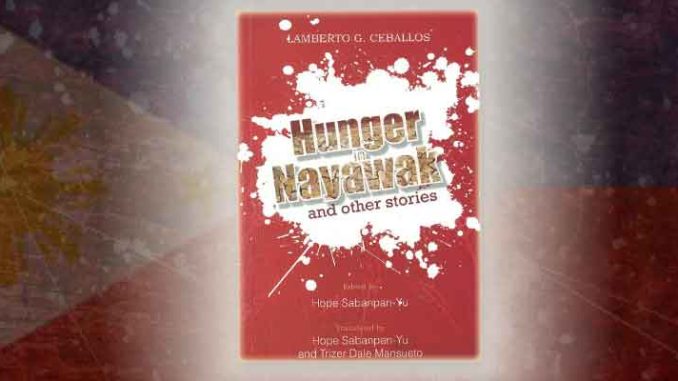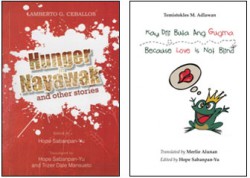
Hope Sabanpan-Yu (editor). 2012.
Hunger in Nayawak and Other Stories.
University of San Carlos Press and Cebuano Studies Center. 256 pages
Humanism in Lamberto G. Ceballos’ short stories
[quote]…Ang maikling kuwento ay sining, at ang sining – ang mataas na uri ng sining – ay higit sa paggagad sa panlabas na anyo ng realidad….Ito ay simbolikong representasyon ng realidad.[/quote]
..The short story is an art, and this kind of art – the ‘high’ type of art – is more than an imitation of the external appearance of reality….This is a symbolic representation of reality. (Ricarte, Pedro. “Tungkol sa Maikling Kuwento,” Panitikan, III, II, Mayo 1967)
Hunger in Nayawak and other stories is a compilation of short stories that aim to “publicize the culture, history, and concerns of Cebu while entertaining the general readers.” The author, who is part of the Cebuano literary canon, is famous for his versatility, mass appeal, and for “producing community-themed work”. He was recognized by Bathalan-ong Halad sa Dagang, Inc-Cebu (Bathalad –Cebu) as the Writer of the Year in 2005. Four years later, his name was inscribed in the same institution’s hall of fame along with Rogelio Pono and Oliver Flores (Sabanpan-Yu, 2012: viii, x).
Aside from being published in magazines, these short stories have reaped awards and acclaim locally and nationally. “Tiggutom sa Nawak” (“Hunger in Nayawak”), from which the title of this anthology is derived, garnered the second place in the Don Carlos Palaca Memorial Awards for Cebuano Literature in 2003. Consequently, the Cebu City government honored his contribution to Cebuano language and culture by approving Resolution No. 03-1091 on September 10, 2003 (Sabanpan-Yu, 2012: viii).
[quote]Unparalleled mastery of the language[/quote]
Lamberto Ceballos’ lush and vivid imagery of the Visayan countryside and his consistent and highly efficient use of the flashback to enhance characterization are the notable distinguishing features of his short stories. Written in Cebuano, Ceballos exhibits seemingly unparalleled mastery of the language as he creatively weaves his narratives and surprises the reader with unforeseen but logical twists in the plot.
 Translating the texts to English must have been challenging. Loban (1966:63) describes words as immensely important. How an individual classifies objects and experiences encountered and how he relates his perceptions are manifested in language. It is impressive for the translators to preserve local color and keep to the syntax of the original version. For instance, the dialogues, though in English, maintained the sprinkling of Cebuano exclamations such as ha, uy, and aw.
Translating the texts to English must have been challenging. Loban (1966:63) describes words as immensely important. How an individual classifies objects and experiences encountered and how he relates his perceptions are manifested in language. It is impressive for the translators to preserve local color and keep to the syntax of the original version. For instance, the dialogues, though in English, maintained the sprinkling of Cebuano exclamations such as ha, uy, and aw.
According to Melendrez-Cruz (1995), the humanism of the Filipino writers of the past lay in stories which appeal for the humane treatment of the disenfranchised and the unfortunate such as the physically and the mentally handicapped (Jose Panganiban’s “Vicenteng Bingi” 1 and Rogelio Sikat’s “Quentin”). Although predominantly regional, some of Ceballos’ short stories share the same outlook with these post-World War II liberal individualist writers with a particular focus on children.
[quote] Compassionate Storytelling[/quote]
“The Road to darkness” narrates the story of the lives of underage laborers in Aduana, the port area near Carbon Market. Fidel, a fourteen-year old stevedore, and Samuel, a child who is slightly older, collect copra in the biggest warehouse by the dock. Samuel saved his life once but he was also caught stealing.
In exchange for their meager salary, they suffer inhuman working conditions and the violent treatment of a warehouseman. Pushed to the wall, they decide to join the other children in stealing copra. The warehouseman caught them in the act and shot Samuel who tried to escape. In revenge, since they were armed with knives, they stabbed the warehouseman. At the sound of the screeching police cars, they scampered away and Fidel found himself in grief beside Samuel’s lifeless body.
In his stories, Ceballos’ city is not the financial district or the location of the seat of political power. He chooses to set his plot in motion in the slums with some connectedness to the red light district and in pockets of isolation such as in “The real identity of Amadix”. Similar to romantic Filipino writers, Ceballos highlights how humanity physically and socially rises above the poverty and ugliness of the slums (Melendrez-Cruz, 1995: 160).
Poldo, the pickpocket with a pregnant wife, turns over a new leaf in “The new door”. He found permanent employment in The New Door Agency that opened its office near his shanty in the pier.
Further, the barrio (or village) is a venue for deep and meaningful relationships among men. “Hunger in Nayawak” opens with Mang Cardo cursing the person who robbed his bananas. The people of Nayawak were suffering from drought. Temoy, the suspect and his neighbor who lived uphill, did not have any source of income. The dry spell killed all the vegetables in his patch. To add, his wife, Dalay, had just given birth. For Mang Cardo, kind and gentle people like Temoy are not exempted from stealing when desperate. He intended to deal with Temoy the way he would with any other thief.
As he was walking back home from his friend’s hut on the hill, he found himself spying on Temoy and his family. His heart softened when he saw Temoy’s undernourished children and his wife who was trying to make the baby suckle. He also overheard Dalay’s sorrow upon learning that the couple had just fed their children with food that was stolen – food that was tainted with dishonesty. At the prodding of Dalay, Temoy headed out to Mang Cardo’s house to admit that he stole the bananas. He also intended to plead for his mercy and borrow corn kernels to mill at home for the nourishment of his family. Since Mang Cardo was just outside their abode, they were able to iron things out immediately. Mang Cardo also lent him three kilograms of corn kernels to mill. Implicitly, it wasn’t only the drought that was to end but the lack of empathy among the residents of Nayawak as well.
The barrio is also a venue for celebration. “There’s time for recompense” showcases a bicycle race that was part of Barangay Santa Monica’s fiesta celebration. “The burnt chapel” provides an account on how people have become more drawn towards the entertainment aspect of the fiesta, thus forgetting its religious essence.
Ceballos’ short stories symbolize reality as he puts forward characters that share common circumstances despite their unique individual experiences. Looking closely, there are men who are lovers, husbands, and sons as well as women who are lovers, wives, and daughters. And their experiences and emotions are part of a bigger humanity – a reflection of the human condition.
Reviewed by Maria Ima Carmela Ariate
Kyoto Review of Southeast Asia. Issue 13 (March 2013). Monarchies in Southeast Asia
Works cited
Loban, Walter. 1966. What language reveals. In James B. Macdonald and Robert R. Leeper, eds. Language and Meaning: Papers from The ACSD Tenth Curriculum Research Institute (pp. 63-73). Washington: Association for Supervision and Curriculum Development, NEA.
Melendrez-Cruz, Patricia. 1995. The Modern Pilipino Short Story (1946-1972): Consciousness and Counter-consciousness. In Elmer A. Ordonez, ed. Nationalist Literature: A Centennial Forum (148-173). 2005: Quezon City: University of the Philippines Press and PANULAT.
Sabanpan-Yu, Hope. 2013. Editor’s Preface. In Hope Sabanpan-Yu, ed. Hunger in Nayawak and other Stories (pp. vii-xvi). 2012: Cebu City: University of San Carlos Press and Cebuano Studies Center.
Notes:
- In English: Vincent the Deaf ↩
